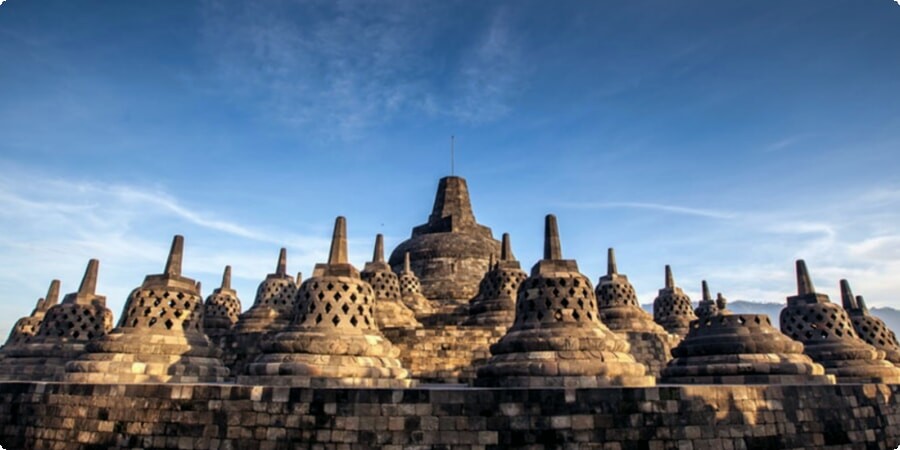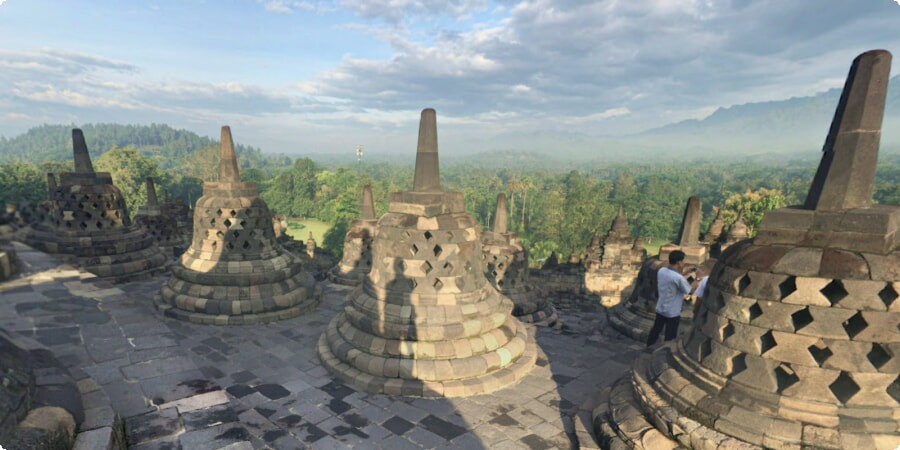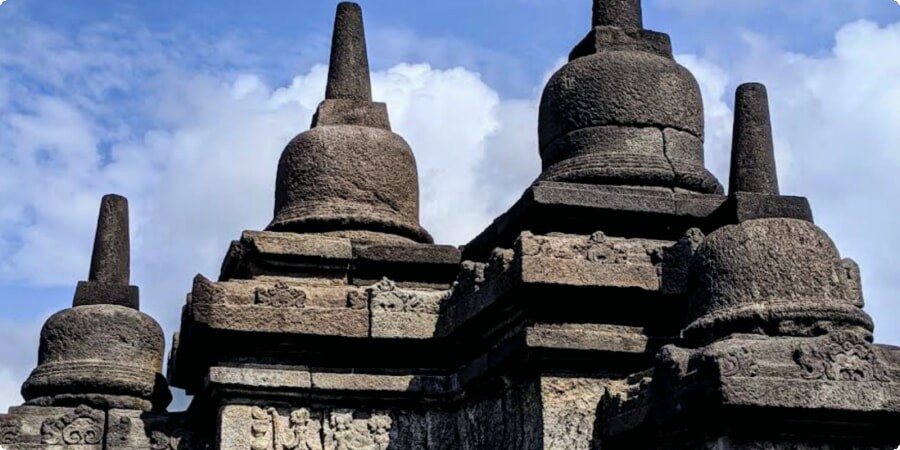Candi Borobudur: A Masterpiece of Indonesian Architecture and Heritage
Welcome to the mystical realm of Candi Borobudur, a mesmerizing UNESCO World Heritage Site nestled amidst the lush landscapes of Indonesia. This ancient temple complex, shrouded in legend and history, stands as a testament to the rich cultural heritage and architectural prowess of the Indonesian people. As you embark on a journey through time, prepare to be enchanted by the splendor and majesty of Candi Borobudur, a masterpiece of Indonesian architecture and heritage.
History of Candi Borobudur
Step back in time to the ancient kingdom of Mataram, where the story of Candi Borobudur begins. Built during the 8th and 9th centuries under the patronage of the Sailendra dynasty, Candi Borobudur served as a monumental expression of Mahayana Buddhism and a pilgrimage site for devout Buddhists from across the region.
Constructed over a period of several decades, Candi Borobudur was painstakingly crafted by skilled artisans and laborers, who adorned its walls with intricate relief sculptures and adorned its terraces with ornate stupas. With its origins rooted in Buddhist cosmology and symbolism, Candi Borobudur stood as a physical representation of the spiritual journey towards enlightenment.
Link: Candi Borobudur - Wikipedia
Architectural Design and Features
Prepare to be captivated by the architectural grandeur and intricate details of Candi Borobudur as you marvel at its magnificent design. Rising majestically from the tropical landscape, Candi Borobudur is comprised of nine stacked platforms, crowned by a central dome and surrounded by seventy-two stupas, each housing a serene Buddha statue.

The temple's structure is adorned with over 2,600 relief panels, depicting scenes from Buddhist teachings, Jataka tales, and daily life in ancient Java. As you explore its labyrinthine corridors and terraces, you'll discover a treasure trove of artistic masterpieces, from delicate carvings of celestial beings to intricate depictions of mythological creatures.
Link: Explore Candi Borobudur on Google Maps
For travelers seeking to explore the cultural riches of Indonesia, including the wonders of Candi Borobudur, it's recommended to book a car in Bali using this link. Having your own transportation allows for flexibility and convenience, ensuring you can explore the region at your own pace and discover hidden gems along the way.
Symbolism and Spiritual Significance
Candi Borobudur is not merely a physical structure; it is a profound symbol of spiritual enlightenment and the journey towards inner peace and harmony. Each element of the temple's design holds deep symbolism, reflecting the core tenets of Buddhism and the human quest for transcendence.
Representation of Buddhist Cosmology: The layout of Candi Borobudur mirrors the Buddhist concept of the universe, with its multiple levels representing different realms of existence. As visitors ascend from the earthly realms to the realm of enlightenment at the summit, they symbolically progress along the path towards Nirvana.

Pilgrimage Destination: For devout Buddhists, Candi Borobudur is not just a tourist attraction; it is a sacred pilgrimage destination where they come to pay homage to the Buddha and seek spiritual fulfillment. The temple's sacred relics and serene atmosphere evoke a sense of reverence and devotion, making it a place of deep significance for practitioners of Buddhism around the world.
Cultural Heritage and Preservation Efforts
As a UNESCO World Heritage Site, Candi Borobudur holds immense cultural significance and serves as a testament to Indonesia's rich heritage and artistic legacy. Efforts to preserve and protect this ancient monument are ongoing, as conservationists work tirelessly to safeguard its structural integrity and historical authenticity.
Preservation Challenges: Despite the best efforts of conservationists, Candi Borobudur faces numerous challenges, including environmental degradation, natural disasters, and the impact of tourism. Conservation efforts focus on mitigating these threats and ensuring that the temple remains a pristine and culturally significant site for future generations to appreciate and admire.
Community Involvement: Engaging local communities in the preservation of Candi Borobudur is essential to its long-term sustainability. Education programs, volunteer opportunities, and cultural events raise awareness about the importance of protecting the temple and empower residents to take an active role in its conservation and management.

Visiting Candi Borobudur: Travel Tips and Recommendations
For travelers planning to embark on a journey to Candi Borobudur and explore the cultural wonders of Indonesia, it's advisable to book a car using this link. Having your own transportation allows for flexibility and freedom to explore the region at your own pace, uncovering hidden treasures and immersing yourself in the rich tapestry of Indonesian culture and heritage.
Preservation Efforts and Conservation Initiatives
Preserving the cultural and historical integrity of Candi Borobudur is a shared responsibility that requires coordinated conservation efforts and sustainable management practices. Conservation initiatives aim to protect the temple from environmental threats, such as erosion, pollution, and natural disasters, while also ensuring that it remains accessible to visitors and future generations.
-
Environmental Protection: Conservation efforts focus on minimizing the environmental impact of human activity around Candi Borobudur, including implementing measures to reduce pollution, manage waste, and conserve water resources. Reforestation projects and soil erosion control measures help to maintain the surrounding ecosystem and protect the temple from erosion and degradation.
-
Structural Restoration: Ongoing restoration projects address structural issues and deterioration caused by aging, weathering, and seismic activity. Skilled craftsmen and conservation experts meticulously repair damaged sections of the temple, using traditional techniques and materials to preserve its authenticity and historical integrity.
Exploring the Surrounding Area of Candi Borobudur
Beyond the temple itself, the surrounding area of Candi Borobudur offers a wealth of cultural and natural attractions waiting to be discovered. From traditional villages and ancient ruins to scenic landscapes and vibrant markets, there's something for everyone to explore and enjoy in this captivating region of Indonesia.

-
Ancient Sites and Temples: Venture beyond Candi Borobudur to explore nearby archaeological sites and ancient temples, including Candi Mendut and Candi Pawon, which are intricately linked to the history and religious significance of the region. These lesser-known treasures provide insight into the rich cultural heritage of Central Java and offer a glimpse into the past.
-
Cultural Experiences: Immerse yourself in the vibrant culture and traditions of Indonesia by visiting local villages and participating in cultural activities, such as traditional dance performances, batik making workshops, and culinary tours. Engaging with local communities offers a unique opportunity to learn about their way of life and connect with the spirit of Indonesia.
Photography Tips for Candi Borobudur in Indonesia
Capture the beauty and majesty of Candi Borobudur with these photography tips and techniques, ensuring that you can preserve your memories of this ancient masterpiece for years to come:
-
Golden Hour: Take advantage of the soft, warm light of sunrise or sunset to capture stunning photos of Candi Borobudur bathed in golden hues. The soft, directional light creates depth and texture, enhancing the intricate details of the temple's architecture and reliefs.
-
Perspective and Composition: Experiment with different perspectives and compositions to capture unique and compelling images of Candi Borobudur. Consider incorporating elements such as leading lines, reflections, and framing to add visual interest and create dynamic compositions.
-
Capture Details: Don't forget to zoom in and capture the intricate details of Candi Borobudur's architecture and carvings. Focus on smaller elements such as decorative reliefs, ornate stupas, and intricate patterns to convey the temple's rich artistic heritage and cultural significance.